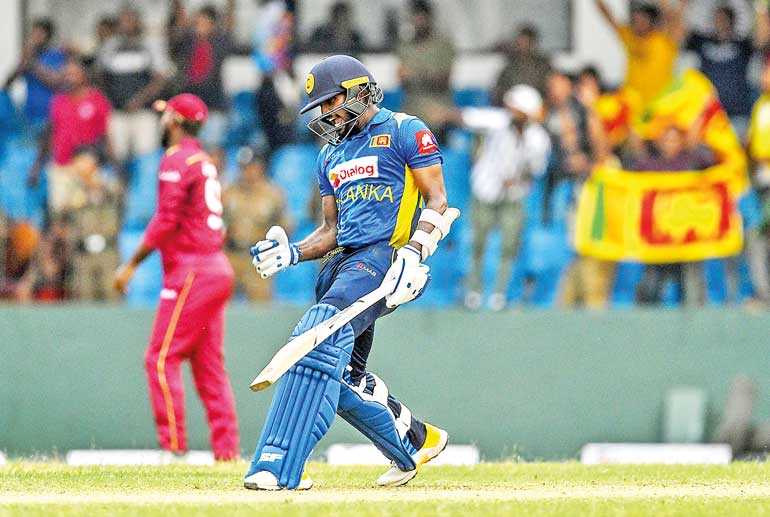Monday Apr 21, 2025
Monday Apr 21, 2025
Monday, 24 February 2020 00:48 - - {{hitsCtrl.values.hits}}

Wanindu Hasaranga celebrates after Sri Lanka won by one wicket during the first one day international (ODI) cricket match between Sri Lanka and West Indies at the Sinhalese Sports Club (SSC) International Cricket Stadium in Colombo on 22 February – AFP
ESPNCricinfo: If Wanindu Hasaranga kept his nerve in the frenzied finish, it’s because he’s been a similar situation before. If he batted cleverly with the tail, and measured the last Sri Lanka push to perfection, it’s because memories of triumphing in arguably tougher circumstances are fresh.
Sri Lanka needed 28 off 27 balls, with only two wickets in hand, when Hasaranga had to really take control of the chase against West Indies. In the end, his 42 not out off 39 balls took Sri Lanka home with one wicket and five balls to spare. Just a month ago, however, Hasaranga had produced a similarly impressive knock, on the same ground, in the final of Sri Lanka’s club T20 competition. On that occasion, his 60 not out off 34 balls, had occasioned a last-ball victory for Colombo Cricket Club.
It was that experience that birthed this cameo.
“I was able to finish a match like this today because the T20 club final innings that I had played,” Hasaranga said. “Also in the practice matches I’d played well from lower in the order. That’s where I will bat in the national team, so even in the club matches I made sure to bat numbers six, seven and eight.
“Yes, they were club matches, but it did have an effect on my mind. I had the confidence that I can play these kinds of innings. As far as I know, someone who can finish matches is the kind of player who can have a long career. I wanted to be someone who could do that for the team.”
Hasaranga had initially played a supporting innings to Thisara Perera, who made 32 off 22 to get Sri Lanka’s requirement down to significantly less than a run-a-ball. Hasaranga revealed, however, that during that partnership with Thisara, Sri Lanka had one eye on the Duckworth-Lewis par score, as the skies had darkened at the time. This would explain Thisara holing out in his attempts to hit a six, even when Sri Lanka needed only 37 off 45.
“When I went to bat we still had 75 to get. Thisara aiya was batting at the time – he had 10 or 15 at the time. He can play the big shots any time. I managed to get a four and a six early on, without too much effort. So I tried to support Thisara when he was batting. I tried to stay in the wicket until it was necessary for me to take a risk.
“When Thisara and I were batting, it also looked like there was a bit of rain in the air. We wondered if the match would stop for bad light or whatever. It was almost 5.30 at the time. But we wanted to be 10 runs in front of the Duckworth-Lewis par score. We didn’t want to throw wickets away. It was because we had tried to get ahead of the rate at that time that I was able to take my time and finish like I did.”
On Friday, on the eve of the match, new coach Mickey Arthur had been glowing in his appraisal of Hasaranga’s all-round ability, marveling at the control in his legbreaks, as well as the energy and efficiency he brought to his batting and fielding. After playing his match-winning innings, Hasaranga touched on the confidence Arthur’s words had prompted.
“The coach is constantly talking to me about things that are expected of me and what I can do for the team – bowl dots in the middle overs and get wickets, do well in the field, and finish a match when we get to situations like this. What he’s told me is that I’m a player who can do all of that.”
Discover Kapruka, the leading online shopping platform in Sri Lanka, where you can conveniently send Gifts and Flowers to your loved ones for any event including Valentine ’s Day. Explore a wide range of popular Shopping Categories on Kapruka, including Toys, Groceries, Electronics, Birthday Cakes, Fruits, Chocolates, Flower Bouquets, Clothing, Watches, Lingerie, Gift Sets and Jewellery. Also if you’re interested in selling with Kapruka, Partner Central by Kapruka is the best solution to start with. Moreover, through Kapruka Global Shop, you can also enjoy the convenience of purchasing products from renowned platforms like Amazon and eBay and have them delivered to Sri Lanka.
Discover Kapruka, the leading online shopping platform in Sri Lanka, where you can conveniently send Gifts and Flowers to your loved ones for any event including Valentine ’s Day. Explore a wide range of popular Shopping Categories on Kapruka, including Toys, Groceries, Electronics, Birthday Cakes, Fruits, Chocolates, Flower Bouquets, Clothing, Watches, Lingerie, Gift Sets and Jewellery. Also if you’re interested in selling with Kapruka, Partner Central by Kapruka is the best solution to start with. Moreover, through Kapruka Global Shop, you can also enjoy the convenience of purchasing products from renowned platforms like Amazon and eBay and have them delivered to Sri Lanka.